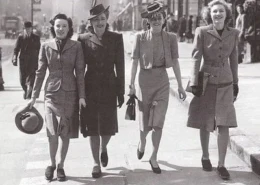The 20th century was a period of dramatic transformation for women’s fashion. Shaped by wars, social change, cultural revolutions, and technological progress, fashion became more than just clothing — it evolved into a reflection of women’s freedom, identity, and empowerment. Each decade left its mark, creating styles that still influence designers and wardrobes today.
1900s: The Edwardian Era
-
Known as the “Belle Époque,” women’s fashion emphasized elegance and formality.
-
The S-bend corset created a dramatic silhouette with a pushed-forward chest and curved hips.
-
Long skirts, high collars, and elaborate hats defined the decade.
-
Fashion symbolized wealth and femininity but restricted women’s mobility.
1910s: Practicality and Wartime Change
-
World War I shifted women’s roles and clothing.
-
Corsets loosened, skirts shortened slightly, and simpler designs emerged.
-
The rise of tailored suits and practical wear reflected women entering the workforce.
-
Designers like Paul Poiret abandoned corsets in favor of freer silhouettes.
1920s: The Flapper Revolution
-
A decade of liberation, marked by shorter hemlines and bobbed haircuts.
-
The flapper dress featured dropped waists, fringe, and sequins, allowing freedom of movement for dancing.
-
Coco Chanel popularized casual chic, jersey fabrics, and trousers for women.
-
Fashion symbolized independence, rebellion, and modernity.
1930s: Elegance Amid Depression
-
The Great Depression made fashion more conservative and practical.
-
Bias-cut dresses, pioneered by Madeleine Vionnet, created sleek, body-skimming looks.
-
Evening gowns emphasized femininity, while daywear was simple and modest.
-
Accessories like hats and gloves remained essential for a polished appearance.
1940s: Utility and Wartime Austerity
-
World War II brought fabric rationing, resulting in shorter skirts and simpler cuts.
-
The utility suit (boxy jackets with padded shoulders and knee-length skirts) was common.
-
Women working in factories wore trousers more widely than ever before.
-
Post-war, Christian Dior’s “New Look” (1947) reintroduced glamour with cinched waists, full skirts, and luxury fabrics.
1950s: Femininity and Domestic Ideals
-
Fashion embraced hourglass figures: cinched waists, full skirts, and fitted bodices.
-
Iconic figures like Audrey Hepburn and Marilyn Monroe set trends.
-
Casual wear expanded, with capri pants, pedal pushers, and sweater sets gaining popularity.
-
The decade reflected post-war prosperity and traditional gender roles.
1960s: Youthquake and Revolution
-
Fashion was driven by youth culture and social change.
-
The miniskirt, pioneered by Mary Quant, became a global symbol of liberation.
-
Bold colors, geometric prints, and mod styles dominated.
-
Hippie fashion (tie-dye, peasant blouses, bell bottoms) reflected countercultural movements.
1970s: Individualism and Experimentation
-
Styles ranged from disco glamour (sequins, platform shoes) to bohemian chic (flowy dresses, ethnic prints).
-
Pantsuits, made popular by Yves Saint Laurent’s Le Smoking, gave women powerful, androgynous options.
-
Feminist movements encouraged practical, comfortable, and expressive clothing.
-
Fashion celebrated diversity and personal choice.
1980s: Power Dressing and Excess
-
Boldness defined the decade: oversized blazers, shoulder pads, and bright colors.
-
The rise of women in corporate environments popularized power suits.
-
Sportswear and designer labels became everyday fashion.
-
Icons like Madonna and Princess Diana influenced both edgy and elegant trends.
1990s: Minimalism and Grunge
-
A stark contrast to the excess of the 1980s.
-
Minimalism: slip dresses, neutral palettes, and clean silhouettes.
-
Grunge: flannel shirts, ripped jeans, and Doc Martens inspired by alternative music.
-
Supermodels like Naomi Campbell and Kate Moss defined runway fashion.
Conclusion
The evolution of women’s fashion in the 20th century tells a story far beyond changing hemlines and fabrics. From the restrictive corsets of the Edwardian era to the liberating trousers, miniskirts, and power suits that followed, fashion mirrored women’s shifting roles in society. Each decade reflected broader historical changes — wars, economic shifts, cultural revolutions, and the ongoing struggle for equality. The century ended with fashion celebrating individuality, setting the stage for the eclectic and inclusive trends of the 21st century.

